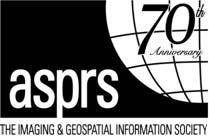

Adoption of the “ASPRS Lidar Guidelines – Vertical Accuracy Reporting for Lidar Data V1.0” was approved by the American Society for Photogrammetry and Remote Sensing (ASPRS) Board of Directors in May 2004. This is the first in a series of guidelines to be published by ASPRS covering the emerging technology of lidar and its use in the mapping sciences. Created by the ASPRS Lidar Committee’s Working Group on lidar guidelines and standards, the guidelines have undergone a public review process and represent the best practices and reporting methods endorsed by ASPRS when working with lidar-derived elevation data.
ASPRS recommends that all mapping professionals adhere to and follow these guidelines when generating or contracting for mapping products derived from lidar data. As part of the Lidar Committee’s Working Group efforts, the ASPRS guidelines were harmonized with the relevant sections of the Guidelines for Digital Elevation Data (Version 1.0) released by the National Digital Elevation Program (NDEP).
The Guidelines cover the recommended methods for measuring and reporting the vertical accuracy of elevation data recorded by airborne lidar mapping instruments. Essentially, they outline necessary steps to analyze the vertical accuracy of elevation data generated using airborne light detection and ranging or laser radar (lidar) technology. In addition, the Guidelines cover determining what level of accuracy can be associated with a mapping product, such as a contour map, that is generated from a given lidar data set (or conversely, what level of accuracy is required in the lidar data to support a given contour interval map). Finally, they also include recommendations for the proper planning and implementation of appropriate ground checkpoints to support a lidar data set, including how to handle different land cover classes across a project site.
“A strategic goal of ASPRS is to proactively develop standards and guidelines for emerging technologies,” said Russell G. Congalton, ASPRS president. “The ASPRS guidelines and reports were developed through input from private companies; public comment; federal, state, and local agencies; as well as individual experts. ASPRS has been diligent in including the Federal Geographic Data Committee process into our work, and included the science of surveying and sound mapping principals. ASPRS is committed to 'standards', which require consensus and a long time to complete the process. By maintaining a leadership role in the development of these lidar guidelines, ASPRS is fulfilling its obligations to its members and all imaging and geospatial information professionals.”
ASPRS strongly encourages all lidar stakeholders to incorporate these guidelines into their lidar mapping projects. A copy of the guidelines can be downloaded from the Lidar Committee section at http://www.asprs.org (under the Photogrammetric Applications Division) or requested from lidar_committee@asprs.org . Other lidar guidelines currently under development by ASPRS for release in 2004 and 2005 include “Horizontal Accuracy Reporting,” “Sensor Calibration,” and “Laser Eye Safety.”
Founded in 1934, ASPRS is an international professional organization of 7,000 geospatial data professionals. ASPRS is devoted to advancing knowledge and improving understanding of the mapping sciences to promote responsible application of photogrammetry, remote sensing, geographic information systems and supporting technologies. For additional information about ASPRS, visit our web site at http://www.asprs.org.
# # #